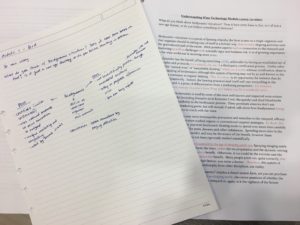This is probably a terrible idea.
So I should definitely do it.
As part of my preparations for the Certified Wine Educator exams, I am going through their online course which is essentially the book club, logically organized all in one place. This course covers many books I’ve been meaning to read and includes exercises (including the essay below) and online quizzes.

I spent five mins brain-dumping and a few more making a brief outline. The red and blue words are the editor’s suggestions.
This was my first timed essay (30 minutes)…in its raw form. I actually took the essay over to fiverr.com and for a grammar check and critique (and learned that I used the word “includes” a lot). It’s no small investment ($12 for this essay), but how can you improve without getting feedback?
To be clear, this was done closed-book in timed conditions (do you also apologize before showing your unpolished work to someone?) Is this helpful?
****************************************************************************
What do you think about biodynamic viticulture? Does it have some basis in fact, is it all just a new age fantasy, or do you believe something in between?
Biodynamic viticulture is a system of farming whereby the farm is seen as a single organism, and that organism should be taking care of itself in a holistic way including aligning activities with the gravitational pull of the moon. It is of growing importance (and receiving more press) in the wine world with some positive aspects (including connection to the vineyard and marketing) and challenges (including scientific rigor and business risk).
Biodynamics has the benefit of being something solidly achievable by having an established set of principles and protocols to follow, including a third-party certification process. Unlike other wine terms like ‘natural wine’ or ‘sustainable farming’ (without certification), there is understanding of biodynamics, although this system of farming may not be as well-known to the end wine consumer as organic farming.
Which is an opportunity for wineries that do farm biodynamically. Indeed, the farming practices that include fermenting cow manure in a cow’s horn (Prep 501) lends itself well to storytelling to consumers, and is definitely a point of differentiation from a marketing perspective.
The fact that biodynamics is used by some of the most well-known and respected wine estates around the world (including Domaine de la Romanee Conti (Burgundy) and Zind Humbrecht (Alsace)) gives credibility to the biodynamic process. These premium wineries don’t use biodynamics as a marketing point, but will instead, if asked, talk about how biodynamics beings the farmer even more in touch with the vines.
Because biodynamics uses more homeopathic prevention and remedies in the vineyard, efficacy might take longer than more studied organic or conventional targeted strategies, which means that a farmer who practices biodynamic farming needs to spend even more time carefully monitoring the vineyard for pests, diseases and other imbalances.
Spending more time in the vineyard is certainly not harmful, and may be the source of the benefit, but these biodynamic treatments have not been rigorously studied scientifically. Spraying stinging nettle tea in the vineyard might not harm the vines, but was it the tea preparation (and the dynamic stirring that made the tea) that was the benefit, or is it the extreme care the farmer is giving the vines the benefit. Many people point out, quite correctly, the the founder of biodynamics, Rudolph Steiner, was never a farmer, and so this system of farming has always been based on philosophy from other disciplines, not reality.
The fact that the definition of biodynamics implies a closed-system farm yet you can purchase the inputs to biodynamic farming (stinging nettle may not grow in your climate, or it might be tricky to secure a stag’s bladder for fermentation) also raises questions of whether the unique treatments give rise to a healthy vineyard or, again, is it the vigilance of the farmer the driver of quality.
Farming biodynamically is a risky endeavor from a business perspective, especially when converting from other farming systems. Like treating a cough with homeopathic remedies may not be as effective as taking traditional cough syrup, there can be a lag time before the vines develop their own balance and self-resistance against pests and diseases.
In the end, there are many examples of premium wines that practice biodynamics. Due to business risks, and because it seems that spending more time studying the vineyard are the only established facts of biodynamics, this farming system may only be appropriate for boutique wines that can get the return on investment for such careful farming practices. Until there is more scientific explanations, biodynamics might not be something that should be widely adopted for all wines at all price points, but it certainly does no material harm in the vineyard, may strengthen the connection between the farmer and the vines and is a unique point of differentiation from a marketing perspective.

